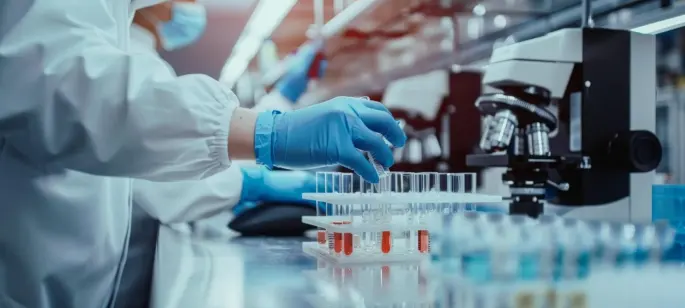-
Intelligent Leadership, Precision and Efficiency: Raytor Instruments Successfully Finishes 2025 National Pharmaceutical R&D Innovation Conference
-
How to increase the absorption of orally administered peptide drugs using Semaglutide as an example?
-
What Is Precision Laboratory Automation and Why It Matters
Automatic degassing system is the quiet fix many dissolution labs overlook. Air hides in the medium, clings to tablets and paddles, and bends your profiles. Results shift. Early points spike. Investigations pile up. Manual deaeration helps, but it is slow and inconsistent. What if preparation were fast, closed, and traceable? What if hydrodynamics stayed stable from prep to draw? In this article, we explain why every dissolution tester needs automated deaeration, how it protects data, and when it makes the biggest difference. The surprising part isn't what it removes - it's what it reveals. Ready to see what your curves are hiding?

What An Automatic Degassing System Solves
Air in the dissolution medium changes flow and shear. It sticks to the dosage form and the apparatus, then skews your concentration curve. Manual deaeration is slow and operator-dependent. Our automatic degassing system streamlines this step so the prep is fast, consistent, and traceable.
- Hydrodynamic integrity: fewer bubbles, more predictable mixing and shear.
- Better repeatability: lower vessel-to-vessel variability and fewer timing offsets.
- Regulatory fit: supports methods aligned with ChP (0931), USP (711/724), and EP (2.9.3/4), especially where gas sensitivity is known.
- Seamless transfer: process parameters are logged so investigations and site transfers are easier.
Typical symptoms that improve after deaeration include spiky early profiles, floating or coning behavior, and poor reproducibility in surfactant-free or low-viscosity media. With controlled heating, vacuum recirculation, inline ultrasonication, or inert-gas sparging, we lower gas solubility and strip dissolved air, then feed the medium directly to vessels or a holding tank with minimal headspace. That prevents re-aeration during transfer - one of the most overlooked risks in the lab.
Automatic Degassing System for Dual-Module Testing
- Closed-Loop Deaeration And Monitoring
RAYTOR's approach keeps the path closed from start to finish. We preheat the medium to a controlled setpoint, then circulate it through a vacuum loop - optionally with inline ultrasonication - to accelerate deaeration. Temperature stability is maintained throughout so you do not drift away from method setpoints. The system monitors and logs time, temperature, vacuum level or flow, and confirms process endpoints before transfer. This creates a complete audit trail for method development, validation, and routine QC.
- Sampling Precision Without Re-Aeration
Degassed medium is only the beginning. Our platform pairs automatic degassing system prep with high-precision, dual-mode automatic sampling:
- Automatic online filtering: dual inline filters stabilize flow, cut particulates, and minimize carryover; the instrument can automatically wash and condition the filters.
- High-precision sampling pump: ensures accurate volumes and stable concentration, with no pipeline residue.
- Synchronized dosing and collection: dosing time is tracked to remove time offsets; samples can be directed to 10 mL tubes or pre-cut cap vials for flexible workflows.
- Optimized injection needle: low residue, high corrosion resistance, and reliable placement.
Because transfer lines and vessel lids remain sealed, re-aeration is minimized from prep to draw. That keeps hydrodynamics intact and reduces unexplained outliers at early time points.
- Built For Compliance And Throughput
Modern labs need capacity without compromising data. RAYTOR's dual-module architecture runs two autonomous dissolution tests simultaneously, each with its own device configuration, speeds, solvents, sampling time points, and methods. Independent temperature probes monitor 12 separate vessels in real time, with live display and alarms. Covered dissolving cups auto-center for fast, accurate setup and long-term durability. You can adjust dissolution medium volume and rotational speed within method limits - without stopping the run - so development teams can explore design spaces efficiently. In QC, the same platform locks down parameters and logs everything for data integrity.

Best Practices And Next Steps
The best results come from pairing smart hardware with disciplined workflow:
- Follow the method: apply deaeration when a method specifies it or when development proves gas sensitivity.
- Keep it closed: sealed transfer lines and tight vessel covers prevent re-aeration.
- Log everything: time, temperature, and process settings should be captured for every batch of medium.
- Recheck after holds: if the medium is stored, verify suitability before use.
In short, an automatic degassing system gives you a repeatable, documented way to remove air, protect hydrodynamics, and improve result reliability - with far less operator dependence than manual deaeration. Combined with RAYTOR's real-time monitoring, dual-module sampling, inline filtration, synchronized dosing, and flexible speed/volume control, your lab gains both compliance and throughput.
Final Words
Ready to stabilize early-time data and boost capacity? Talk to a RAYTOR specialist today about integrating an automatic degassing system with your dual-module dissolution workflow, and see how consistent prep, sealed transfers, and precise sampling can elevate your methods from development to QC.



